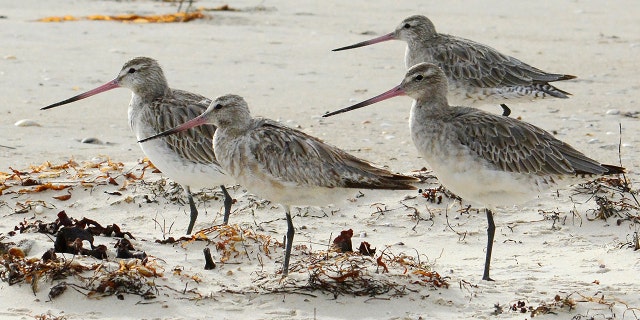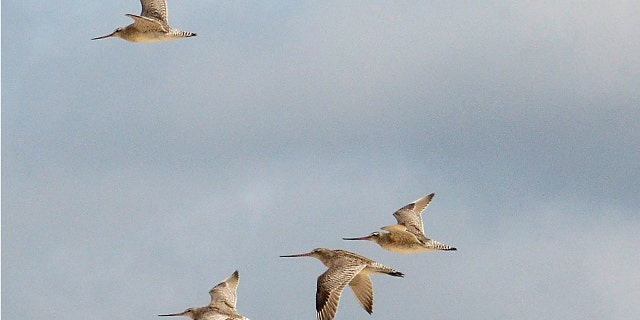Member of sandpiper family may have set a new non-stop distance flight record for migratory birds
By Maureen Mackey | Fox News
A bird has flown non-stop, apparently, from Alaska to the Australian state of Tasmania.
And now this young bar-tailed godwit — a member of the sandpiper family — appears to have set a non-stop distance record for migratory birds.
It flew at least 13,560 kilometers — or 8,435 miles — during that flight, a bird expert said on Friday, as the Associated Press reported.
The bird was tagged as a hatchling in Alaska during the Northern Hemisphere summer, the AP also noted.
It had a tracking GPS chip and tiny solar panel that allowed an international research team to follow its first annual migration across the Pacific Ocean, BirdLife Tasmania convenor Eric Woehler told the AP.

Bar-tailed godwits stand on the beach at Marion Bay in Australia's Tasmania state on Feb. 17, 2018. A young bar-tailed godwit appears to have set a non-stop distance record for migratory birds by flying at least 8,435 miles from Alaska to the Australian state of Tasmania, a bird expert said Oct. 28, 2022. (Eric Woehler via AP)
Because the bird was so young, its gender was not known.
Yet at about five months old, it left southwest Alaska at the Yukon-Kuskokwim Delta on Oct. 13.
Eleven days later, touched down at Ansons Bay on the island of Tasmania’s northeastern tip on Oct. 24.
That's according to data from Germany’s Max Planck Institute for Ornithology. The research has yet to be published or peer reviewed, the AP said.
‘Big, noisy and cinnamon-colored’
Widespread in summer across Northern Europe and Asia, the godwit crosses the Bering Strait to nest in western Alaska, according to Audubon.
"Big, noisy and cinnamon-colored, it is conspicuous on its tundra nesting grounds," the same source also says.
"Bar-tailed godwits from Alaska spend the winter in the Old World. A few may show up on either coast of North America in migration — [and] such strays, in dull winter plumage, often associate with flocks of other godwits, where they are easily overlooked."

Bar-tailed godwits are shown flying over Marion Bay in Australia's Tasmania state on Dec. 27, 2013. A young bar-tailed godwit appears to have set a non-stop distance record for migratory birds by flying at least 13,560 kilometers (8,435 miles) from Alaska to the Australian state of Tasmania, a bird expert said on Friday, Oct. 28, 2022. (Eric Woehler via AP)
Godwits feed on insects, crustaceans and mollusks, Audubon says.
"In summer in Alaska, [the bird] feeds mainly on aquatic insects, also occasionally seeds and berries. On mudflats and shores at other seasons, [it] feeds on crustaceans, mollusks, insects [and] annelid worms."
Tracking the bird
The bird started on a southwestern course toward Japan — then turned southeast over Alaska’s Aleutian Islands, a map published by New Zealand’s Pūkorokoro Miranda Shorebird Centre shows, the AP reported.
The bird was again tracking southwest when it flew over or near Kiribati and New Caledonia, then past the Australian mainland before turning directly west for Tasmania, Australia’s most southerly state.
"Whether this bird got lost or whether this is part of a normal pattern of migration for the species, we still don’t know."
The satellite trail showed that the bird covered 13,560 kilometers (8,435 miles) without stopping.
"Whether this is an accident, whether this bird got lost or whether this is part of a normal pattern of migration for the species, we still don’t know," said Woehler, who is part of the research project.
The longest recorded migration by a bird without stopping for food or rest is 12,200 kilometers — 7,580 miles — according to Guinness World Records.
That record was set by a satellite-tagged male bar-tailed godwit flying from Alaska to New Zealand.
That flight was recorded in 2020 as part of the same decade-old research project — which also involves China’s Fudan University, New Zealand’s Massey University and the Global Flyway Network, the AP noted.
The same bird broke its own record with a 13,000-kilometer — 8,100-mile — flight on its next migration last year, researchers say.
However, Guinness has yet to acknowledge that feat.
Researchers hope to see the bird once wet weather clears in the remote corner of Tasmania — where it will fatten up, after having lost half its body weight during its long journey.
Woehler said researchers did not know whether the latest bird, known by its satellite tag 234684, flew alone or as part of a flock.
He also told the AP that he hopes to see the bird once wet weather clears in the remote corner of Tasmania — where it will fatten up, after having lost half its body weight during its long journey.
The bar-tailed godwit first breeds at two years of age, according to Audubon.
The territorial and courtship display of the male "involves loud calls and aerial acrobatics" — deep wingbeats alternating with glides — as the male bird circles high above tundra, the same source says.
The "nest site is usually on a raised hummock, surrounded by grass. Nest is a shallow depression, lined with bits of grass, moss, lichens."
The eggs of this bird usually number four, Audubon also notes — and those eggs are olive or pale brown, usually with a few brown spots. The eggs hatch in about three weeks.
The age of the young bird at first flight? That's probably at about day 30, Aubudon says.
The Associated Press contributed reporting.
No comments:
Post a Comment